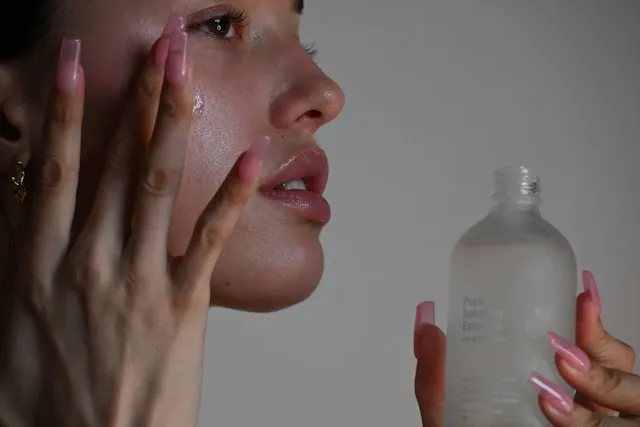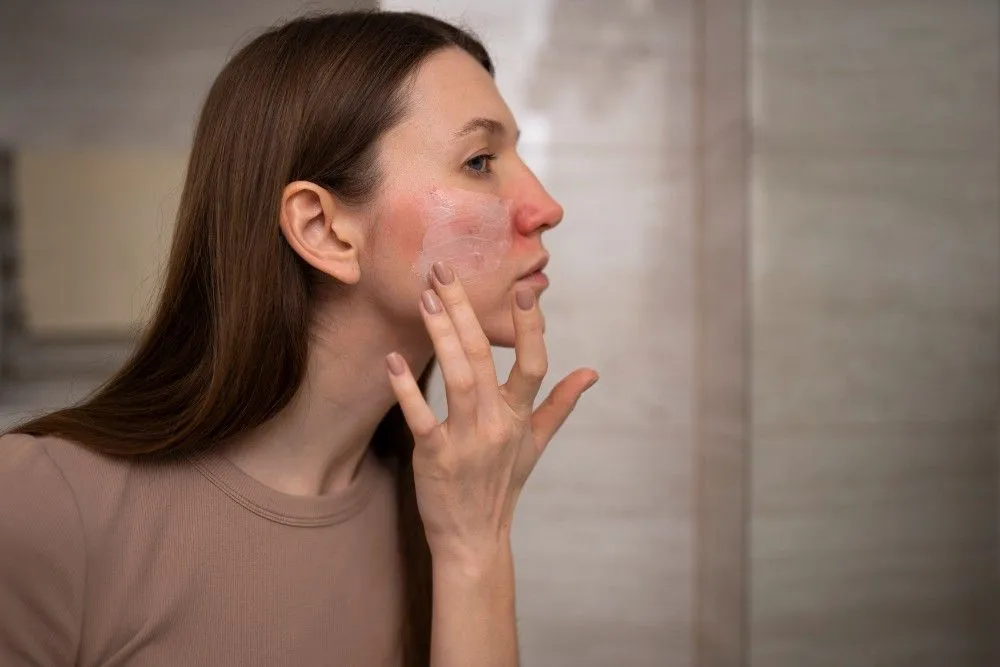What is Perioral Dermatitis?
Perioral dermatitis is an inflammatory facial eruption that shows up as clusters of tiny red or skin-coloured bumps around the mouth, sides of the nose, and sometimes the eyelids (periocular dermatitis). Skin can feel tight, stingy, or itchy. Unlike acne, there are no deep, painful nodules, and comedones are uncommon.
Common Triggers
-
Topical steroids on the face, including “mild” over-the-counter hydrocortisone. Flares often rebound when the steroid is stopped.
-
Heavy skincare and makeup such as thick balms, oils, and occlusive primers.
-
Irritants, including fragrance, essential oils, alcohol based toners, and harsh scrubs.
-
Fluoride or tartar-control toothpastes and spicy toothpaste flavours.
-
Photoprotection gaps and strong UV or wind exposure.
-
Hormonal shifts and stress, which can heighten skin reactivity.
Dr. Shamsa Kanwal, a consultant dermatologist and expert contributor to MyHSTeam, emphasizes the importance of identifying triggers: "Perioral dermatitis often improves dramatically once we identify and remove the specific triggers. The key is taking a methodical approach to elimination and simplification of your routine."
How to Calm a Flare: Dermatologist-Approved Routine
Morning
-
Gentle cleanse with a sulfate-free, fragrance-free cleanser.
-
Lightweight moisturizer with barrier-soothing actives like Niacinamide, Squalane, Saccharide Isomerate, PEACHCALM, SYRICALM, or SEPIBLISS FEEL.
-
Broad-spectrum SPF 50 that is non-comedogenic. Mineral filters are often best for reactive skin.
Evening
-
Remove sunscreen and makeup with a mild cleanser. Avoid balms or oils that leave a film.
-
Reapply a simple moisturizer. Look for labels that say non-comedogenic and fragrance-free.
-
Skip exfoliants, retinoids, and strong acids until the rash is quiet for at least 2 to 3 weeks.
Dermatologist tips
-
Switch to a simple toothpaste without whitening agents or strong mint.
-
Wash makeup brushes weekly and avoid heavy foundations during active flares.
-
If you have been using a steroid cream on your face, do not stop abruptly without a plan. A short medical taper plus anti-inflammatory topicals is often needed.
Medical Treatments Your Dermatologist May Prescribe
-
Topical anti-inflammatories: metronidazole, azelaic acid, ivermectin, or pimecrolimus.
-
Antibiotic therapy: a short course of doxycycline or minocycline for moderate to severe cases.
-
Trigger management: guidance on stopping facial steroids safely and rebuilding the barrier.
Most patients see improvement in 2 to 4 weeks, with clearer skin in 6 to 8 weeks when triggers are controlled and treatment is consistent.
What to Avoid During a Flare
-
Topical steroids on the face unless your doctor gives a taper schedule.
-
Harsh scrubs, strong acids, and retinoids.
-
Heavy occlusives like thick oils, petrolatum-rich balms, or waxy primers.
-
Fragrance, essential oils, and alcohol based toners.
-
Whitening or strong mint toothpastes.
Best Ingredients for Soothing, Non-Comedogenic Care
-
Niacinamide: calms redness, supports barrier, balances oil.
-
Squalane: light emollient that softens without clogging pores.
-
Saccharide Isomerate: long-lasting hydration that reduces tightness.
-
PEACHCALM, SYRICALM, SEPIBLISS FEEL, Unisooth ST: botanical complexes that reduce sting, itch, and visible redness.
Always patch test new products on the jawline for 48 hours.
When to See a Dermatologist
-
The rash worsens or spreads toward the eyes.
-
You need help tapering off a steroid cream.
-
Significant burning, scaling, or recurrent flares despite gentle care.
-
You are pregnant or breastfeeding and need treatment options that are safe for you.
Did You Know? Perioral dermatitis often improves simply by removing the culprit, and in studies, the most common culprit is a facial steroid cream used for “irritation.” The skin can become steroid-dependent, so stopping without a plan can briefly worsen the rash before it gets better. That rebound is expected and manageable with the right taper and gentle care.
Conclusion
Perioral dermatitis thrives on irritation and heaviness. Clear the clutter, stop facial steroids with a safe plan, protect with a simple mineral SPF 50, and rebuild your barrier with non-comedogenic, fragrance-free hydrators. If flares persist or involve the eye area, see a dermatologist for targeted prescriptions and a tapered exit strategy. With consistency, most patients regain a calm, comfortable complexion.
أسئلة متكررة
Is perioral dermatitis the same as acne or rosacea?
No. It can overlap with rosacea, but perioral dermatitis has small papules around the mouth or nose with more stinging and less oil congestion than acne.
Can sunscreen make it worse?
Fragrant or heavy sunscreens can. Choose mineral, fragrance free, non-comedogenic SPF 50 and apply over a simple moisturizer.
How long does it take to clear?
Mild cases may settle in 2 to 4 weeks with trigger removal and a simple routine. Moderate to severe cases often need 6 to 8 weeks plus prescriptions.
Do I have to stop all actives forever?
No. Pause until fully calm. Later, reintroduce gently, one change every 2 to 3 weeks. Many patients tolerate azelaic acid well during maintenance.
Is toothpaste really a problem?
For some people, yes. Trial a non-whitening, mild mint or flavour-free formula for 3 to 4 weeks and see if flares reduce.
Will moisturizers clog my rash?
Choose lightweight, non-comedogenic textures. Hydration supports healing and reduces sting.
كُتب بواسطة







